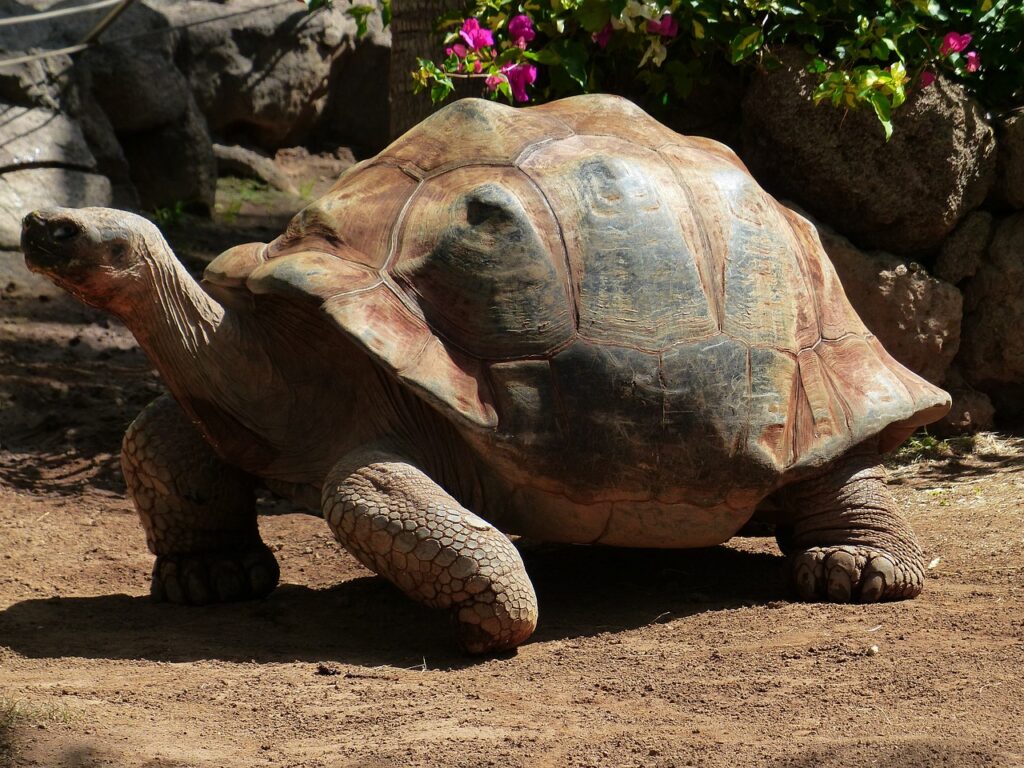Caring for a Sulcata Tortoise? Absolutely! These magnificent creatures make for fascinating pets – but they need special care to stay healthy.
Habitat-wise, they require plenty of space to roam and explore. A Sulcata can reach up to three feet in length, so make sure their enclosure is spacious. Heat and UVB lighting sources are also essential for their well-being.
Digging burrows is another thing these ancient reptiles do naturally. As an owner, you must provide a substrate for them to do this. It’s crucial for their safety!
The Sulcata tortoise has been around for millions of years. Fossils discovered suggest that their ancestors roamed the earth during the Pleistocene era – simply amazing!
So, if you want to be a Sulcata tortoise owner, remember: they require dedication and understanding of their needs. Create a habitat that mimics their natural one and provide proper nutrition – this is the key to keeping them happy and healthy for many years to come!
Key Takeaways
- Provide a spacious and secure enclosure: Sulcata tortoises require a large and secure enclosure to roam and explore. Ensure that the enclosure has a solid fence or wall to prevent escape and protect them from predators.
- Create a suitable habitat: Mimic the natural habitat of a Sulcata tortoise by providing a mix of grassy areas, sandy patches, and hiding spots. It is important to maintain a warm and dry environment with proper lighting and temperature gradients.
- Offer a balanced diet: Sulcata tortoises are herbivores and need a diet rich in fiber and calcium. Provide a variety of leafy greens, grasses, and hay, and supplement their diet with calcium and vitamin D3 to promote healthy shell growth.
- Ensure proper hydration: Sulcata tortoises need access to fresh water at all times. Soaking them in shallow water regularly helps prevent dehydration and aids in shedding.
- Monitor their health: Regularly check for signs of illness or injury, such as shell abnormalities, respiratory issues, or changes in appetite. If any concerns arise, consult a veterinarian experienced in reptile care.
- Handle with care: Sulcata tortoises are not pets that enjoy being handled frequently. Minimize handling to avoid stress and injury to the tortoise. When necessary, support their body properly and avoid lifting them by their shell.
- Provide opportunities for exercise: Encourage natural behaviors by providing opportunities for exercise, such as climbing structures or obstacles. This helps keep them physically and mentally stimulated.
- Educate yourself: Continuously educate yourself about Sulcata tortoise care to ensure you are providing the best possible environment and meeting their specific needs. Stay updated on any new research or guidelines in tortoise care.
- Remember, caring for a Sulcata tortoise is a long-term commitment, as they can live for several decades. Providing them with proper care and attention will help ensure their health and well-being.
Understanding the Sulcata Tortoise

Sulcata Tortoises are fascinating creatures that need special care. They are the third biggest species of tortoise and can reach up to three feet in length. These old reptiles have a lifetime of more than 70 years and come from the Sahel region of Africa.
These tortoises flourish in hot and dry climates, making them terrific pets for desert dwellers. It is essential to give them an outside enclosure that resembles their natural habitat, with lots of space to wander and bask in the sun. Plus, their diet is mainly composed of grasses, weeds, and fibrous vegetables.
A special trait of Sulcata Tortoises is their capacity to dig deep burrows. These underground shelters serve as defense against intense temperatures and predators. To replicate this natural action, it is suggested to give these tortoises an area within their enclosure where they can dig.
Pro Tip: Regular vet check-ups are necessary for making sure the overall health and wellbeing of your Sulcata Tortoise. Book meetings with a reptile specialist who has experience in taking care of these special creatures.
Building the perfect shellter for your sulcata tortoise – because their dream home shouldn’t just be a shell of its former self.
Creating the Ideal Habitat
Creating the perfect home for a Sulcata Tortoise needs careful planning. The right environment will keep your tortoise healthy and content.
- Enclosure: An outdoor pen with secure fencing is essential for a Sulcata Tortoise to move around.
- Temperature: Maintain temperatures between 75-90 Fahrenheit in the day and lower at night.
- Humidity: Provide misting and a shallow water bowl to drink and bathe in.
- Diet: Greens, vegetables, and the occasional fruit.
- Behavior: Deep soil or sand to burrow and make nests. Plus, rocks or hollow logs as hiding spots. Clean the space regularly too.
In addition, get a UVB lamp to give your tortoise enough vitamin D3 for shell development. Serve a varied diet for all the nutrients. Finally, check up with the vet to monitor health and address any problems quickly.
By providing an ideal habitat and following these tips, you can ensure your Sulcata Tortoise is happy and healthy.
Feeding and Nutrition
Feeding and nutrition is key for your Sulcata tortoise’s wellness. Here are a few points to keep in mind:
- Give a selection of dark, leafy greens such as kale and dandelion greens.
- Supplement their diet with veggies like carrots, bell peppers, and squash.
- Give occasional fruits like strawberries or melons as treats.
- Ensure a calcium-rich diet by giving supplements like cuttlefish bone or calcium powder.
Remember to avoid foods high in oxalates, like spinach and rhubarb leaves. Also, stay away from food high in phosphorus or protein such as meat or dairy products.
Offer smaller pieces of food that your tortoise can manage. This will help stop choking or blockages in their digestive system.
By providing nutritious and varied food, you can help your Sulcata tortoise’s health and life for years. Start implementing these tips today and enjoy watching your tortoise grow! Be careful with your Sulcata tortoise, or they’ll make you their slow-paced target for all their seafood cravings.
Handling and Socializing

Handling and socializing with a Sulcata Tortoise requires patience and delicacy. These majestic creatures have a gentle nature, yet can be easily startled. So it’s important to approach them slowly, calmly, and without sudden movements or loud noises. When you handle your tortoise, support their shell properly, as it is sensitive and can be injured. To bond, spend quality time together, talking softly, and gently stroking their scales.
Introduce your Sulcata Tortoise to new environments gradually. Begin by letting them explore a small, enclosed space. It could be a play area in your home or an outdoor enclosure (if the weather permits). As they become more comfortable, gradually expand their environment.
Socialize your tortoise by interacting with other pets. But do so carefully, and make sure the animals are compatible. Monitor the interactions closely and intervene if needed, for both your tortoise and other pets’ safety.
The ancient Egyptians revered Sulcata Tortoises as symbols of longevity and protection. This is due to their long lifespan and sturdy shells. In Egyptian artwork, they were often depicted carrying the sun god Ra on their backs during his daily journey across the sky. This showcases their significance throughout history.
Remember: if your sulcata tortoise seems unwell, seek veterinary care. It’s not a shellfish cry for attention – it’s serious!
Health and Veterinary Care

Sulcata tortoises need special attention for their health and vet care. Here are the main points to take into account:
- Diet: Balance is key for their wellbeing. Grass, veg and some fruit should make up their meals.
- Habitat: Give them a space with a burrowing substrate. Keep the temp and humidity right.
- Check-ups: See a specialist tortoise vet for routine exams, checkups and vaccinations.
- Hygiene: Clean the enclosure to prevent infections. Remove waste, disinfect, and offer fresh water.
- Disease prevention: Take preventive measures like good hygiene, careful introduction of new animals, and quarantine.
Plus, each Sulcata has unique shell patterns to identify them if they go missing.
A true story of a Sulcata named Tank shows the importance of health and veterinary care. Tank had an infection on his hind leg and the vet successfully operated and treated it. This shows how vital care is for these creatures.
Lifespan and Reproduction
Sulcata tortoises have an incredible long life. They can live for over 70 years in captivity. They become sexually mature around 15-20 years. Their longevity is due to their ability to hibernate. It helps them conserve energy and survive harsh conditions.
Fascinatingly, males use head movements to court females. Females lay eggs annually in carefully selected nesting sites. After 80-120 days, these eggs hatch into baby tortoises.
Biologists and herpetologists have studied these creatures closely. They have shared valuable insights into their biology and behavior.
Owning a Sulcata tortoise is a lifelong commitment. It’ll make every hare pass you by!
Frequently Asked Questions
Q1: What should I feed my Sulcata tortoise?
A1: Sulcata tortoises thrive on a diet that consists mainly of grasses, hay, and leafy greens. They should also be provided with a calcium supplement and a source of water at all times.
Q2: How often should I bathe my Sulcata tortoise?
A2: Sulcata tortoises should be bathed at least once a week to help keep their skin hydrated and to ensure proper shedding. Make sure the water is lukewarm and never leave your tortoise unattended during a bath.
Q3: How do I create a suitable habitat for my Sulcata tortoise?
A3: The habitat for a Sulcata tortoise should include a large and secure enclosure with plenty of space to roam. It should have a substrate of grass or hay and be equipped with hiding spots, basking areas, and UVB lighting.
Q4: How can I protect my Sulcata tortoise from extreme temperatures?
A4: Sulcata tortoises are highly sensitive to extreme temperatures. Provide shaded areas within the enclosure where they can cool off during hot weather. During colder months, provide a heated shelter or move your tortoise indoors to prevent temperature-related health issues.
Q5: How often should I take my Sulcata tortoise to the veterinarian?
A5: It is recommended to have an initial wellness examination for your Sulcata tortoise when first acquiring it. Afterward, regular check-ups should be scheduled at least annually to ensure their overall health and to address any potential concerns.
Q6: Are Sulcata tortoises good with children and other pets?
A6: Sulcata tortoises are generally not recommended as pets for young children due to their large size and specific care requirements. They should also be kept separate from other pets, as their interactions may cause stress or harm to both the tortoise and the other animals involved.
Conclusion
Caring for a Sulcata Tortoise needs careful attention to their home, diet, and health. Building a habitat with the perfect temperature and moisture is essential. A balanced diet of leafy greens, veggies, and rare fruits is vital for their well-being. Monitoring their health regularly and vet care when needed is important. They can live up to 50-70 years!
In understanding the demands of Sulcata Tortoises, it’s key to make an appropriate habitat. An ample enclosure with shade and basking spots lets them control their body heat. The temperature should be 80-85°F (26-29°C) in the day and lower at night. Moisture of 50-70% is needed to keep their shells from drying out.
For nutrition, a well-balanced diet is necessary. High-fiber leafy greens like dandelion greens, collard greens, and hibiscus leaves should be the main part. Veggies like carrots, squash, and bell peppers can add variety and nutrients. Fruits should only be given occasionally, but favorites like berries or melons can be treats.
Health check-ups are vital for Sulcata Tortoises. An experienced reptile vet can help spot any issues early on and give the right treatment. Regular examinations for shell damage or respiratory problems are important in catching out any health problems.
True Fact: According to the World Animal Foundation, Sulcata Tortoises are the third-largest species and can weigh up to 200 pounds (90 kg) in adulthood.
References




